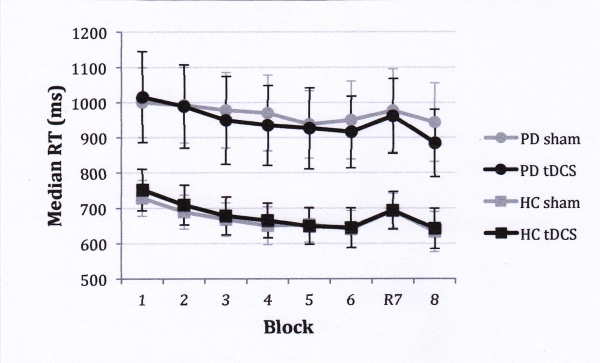Session Information
Date: Wednesday, June 22, 2016
Session Title: Parkinson's disease: Cognition
Session Time: 12:00pm-1:30pm
Location: Exhibit Hall located in Hall B, Level 2
Objective: To examine the potential effect of tDCS on the acquisition of implicit sequential motor skill learning in persons with PD (pwPD).
Background: Due to the basal ganglia shortage of dopamine, motor sequence learning is compromised in pwPD. tDCS has been shown to boost learning of sequential motor skills in healthy individuals.
Methods: 18 pwPD in H&Y stage II or III and 18 matched healthy controls participated. All subjects performed 4 sessions of a serial reaction time (SRT) task under 2 conditions: 2 sessions with tDCS-application and 2 sessions with sham-tDCS. Both conditions were separated by 1 week and were counterbalanced. In the SRT-task subjects had to press 1 of 4 keyboard keys associated with the location of 4 stimulus locations on a computer screen. Without informing the subjects a 12-element sequence was placed on the target’s location and continuously cycled. 8 blocks of 72 trials were performed of which in block 7 the sequence was at random. The median reaction time (RT) is the outcome parameter. tDCS was applied for 20 min on the primary motor cortex C3 or C4 with the reference cathode on the contralateral forehead. The current density was 0.052 mA/cm2 or no current in the sham condition. A mixed factorial ANOVA was implemented to analyse the SRT task performance.
Results: For the blocks 1-6 and 8 there was a main effect of group and of block, but no significant interaction effect, indicating a general learning effect with slower reaction times of the pwPD. Sequence learning was derived from comparing RTs in random block 7 with the mean of surrounding blocks 6 and 8. A main effect of group and a main effect of sequence learning were found and also a tendency for group x stimulation x sequence learning interaction (F(1,33)=3.38, p=.074). The amount of sequence learning in controls was not significantly different between tDCS and sham conditions (p=.671). However, pwPD showed significantly more sequence learning under tDCS (61 ± 85ms) compared to the sham stimulation (30 ± 99.8 ms) (p=.039).  Fig: median RTs per block and stimulation condition (sham/ tDCS) for pwPD (PD) and healthy controls (HC). All blocks are sequenced, except for random Block 7.
Fig: median RTs per block and stimulation condition (sham/ tDCS) for pwPD (PD) and healthy controls (HC). All blocks are sequenced, except for random Block 7.
Conclusions: We found a positive effect of tDCS on the acquisition of sequential motor skill learning in pwPD. This finding supports the therapeutic potential of tDCS to promote motor performance in PD.
To cite this abstract in AMA style:
E. Kerckhofs, N. Deroost. The effect of anodal transcranial direct current stimulation (tDCS) on sequential motor skill learning in persons with Parkinson’s disease [abstract]. Mov Disord. 2016; 31 (suppl 2). https://www.mdsabstracts.org/abstract/the-effect-of-anodal-transcranial-direct-current-stimulation-tdcs-on-sequential-motor-skill-learning-in-persons-with-parkinsons-disease/. Accessed November 6, 2025.« Back to 2016 International Congress
MDS Abstracts - https://www.mdsabstracts.org/abstract/the-effect-of-anodal-transcranial-direct-current-stimulation-tdcs-on-sequential-motor-skill-learning-in-persons-with-parkinsons-disease/
